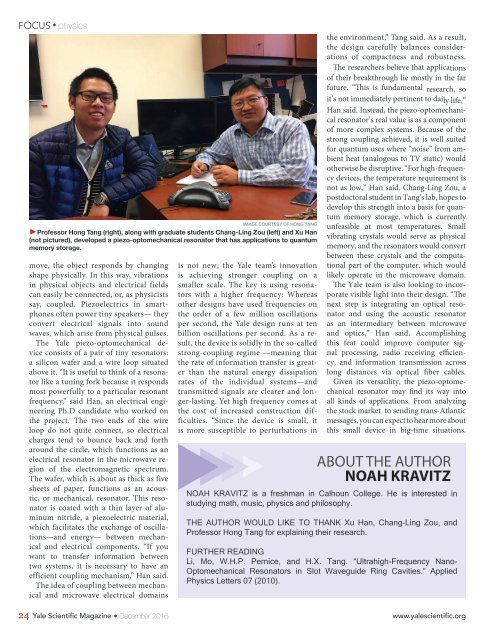YSM Issue 90.1
You also want an ePaper? Increase the reach of your titles
YUMPU automatically turns print PDFs into web optimized ePapers that Google loves.
FOCUS<br />
physics<br />
IMAGE COURTESY OF HONG TANG<br />
►Professor Hong Tang (right), along with graduate students Chang-Ling Zou (left) and Xu Han<br />
(not pictured), developed a piezo-optomechanical resonator that has applications to quantum<br />
memory storage.<br />
move, the object responds by changing<br />
shape physically. In this way, vibrations<br />
in physical objects and electrical fields<br />
can easily be connected, or, as physicists<br />
say, coupled. Piezoelectrics in smartphones<br />
often power tiny speakers— they<br />
convert electrical signals into sound<br />
waves, which arise from physical pulses.<br />
The Yale piezo-optomechanical device<br />
consists of a pair of tiny resonators:<br />
a silicon wafer and a wire loop situated<br />
above it. “It is useful to think of a resonator<br />
like a tuning fork because it responds<br />
most powerfully to a particular resonant<br />
frequency,” said Han, an electrical engineering<br />
Ph.D candidate who worked on<br />
the project. The two ends of the wire<br />
loop do not quite connect, so electrical<br />
charges tend to bounce back and forth<br />
around the circle, which functions as an<br />
electrical resonator in the microwave region<br />
of the electromagnetic spectrum.<br />
The wafer, which is about as thick as five<br />
sheets of paper, functions as an acoustic,<br />
or mechanical, resonator. This resonator<br />
is coated with a thin layer of aluminum<br />
nitride, a piezoelectric material,<br />
which facilitates the exchange of oscillations—and<br />
energy— between mechanical<br />
and electrical components. “If you<br />
want to transfer information between<br />
two systems, it is necessary to have an<br />
efficient coupling mechanism,” Han said.<br />
The idea of coupling between mechanical<br />
and microwave electrical domains<br />
is not new; the Yale team’s innovation<br />
is achieving stronger coupling on a<br />
smaller scale. The key is using resonators<br />
with a higher frequency: Whereas<br />
other designs have used frequencies on<br />
the order of a few million oscillations<br />
per second, the Yale design runs at ten<br />
billion oscillations per second. As a result,<br />
the device is solidly in the so-called<br />
strong-coupling regime —meaning that<br />
the rate of information transfer is greater<br />
than the natural energy dissipation<br />
rates of the individual systems—and<br />
transmitted signals are clearer and longer-lasting.<br />
Yet high frequency comes at<br />
the cost of increased construction difficulties.<br />
“Since the device is small, it<br />
is more susceptible to perturbations in<br />
the environment,” Tang said. As a result,<br />
the design carefully balances considerations<br />
of compactness and robustness.<br />
The researchers believe that applications<br />
of their breakthrough lie mostly in the far<br />
future. “This is fundamental research, so<br />
it’s not immediately pertinent to daily life,”<br />
Han said. Instead, the piezo-optomechanical<br />
resonator’s real value is as a component<br />
of more complex systems. Because of the<br />
strong coupling achieved, it is well suited<br />
for quantum uses where “noise” from ambient<br />
heat (analogous to TV static) would<br />
otherwise be disruptive. “For high-frequency<br />
devices, the temperature requirement is<br />
not as low,” Han said. Chang-Ling Zou, a<br />
postdoctoral student in Tang’s lab, hopes to<br />
develop this strength into a basis for quantum<br />
memory storage, which is currently<br />
unfeasible at most temperatures. Small<br />
vibrating crystals would serve as physical<br />
memory, and the resonators would convert<br />
between these crystals and the computational<br />
part of the computer, which would<br />
likely operate in the microwave domain.<br />
The Yale team is also looking to incorporate<br />
visible light into their design. “The<br />
next step is integrating an optical resonator<br />
and using the acoustic resonator<br />
as an intermediary between microwave<br />
and optics,” Han said. Accomplishing<br />
this feat could improve computer signal<br />
processing, radio receiving efficiency,<br />
and information transmission across<br />
long distances via optical fiber cables.<br />
Given its versatility, the piezo-optomechanical<br />
resonator may find its way into<br />
all kinds of applications. From analyzing<br />
the stock market to sending trans-Atlantic<br />
messages, you can expect to hear more about<br />
this small device in big-time situations.<br />
ABOUT THE AUTHOR<br />
NOAH KRAVITZ<br />
NOAH KRAVITZ is a freshman in Calhoun College. He is interested in<br />
studying math, music, physics and philosophy.<br />
THE AUTHOR WOULD LIKE TO THANK Xu Han, Chang-Ling Zou, and<br />
Professor Hong Tang for explaining their research.<br />
FURTHER READING<br />
Li, Mo, W.H.P. Pernice, and H.X. Tang. “Ultrahigh-Frequency Nano-<br />
Optomechanical Resonators in Slot Waveguide Ring Cavities.” Applied<br />
Physics Letters 07 (2010).<br />
24 Yale Scientific Magazine December 2016 www.yalescientific.org


















